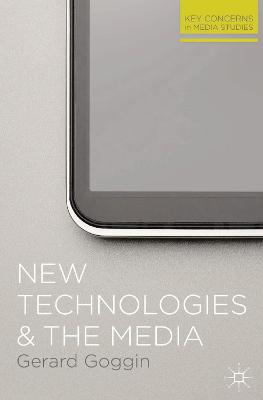Key Concerns in Media Studies
2 total works
The landscape of the media is changing - and at an ever-increasing pace. New technologies are fast transforming the way we consume information, and the way we live our lives. New Technologies and the Media by Proffessor Gerard Goggin (University of Sydney) is an authoritative exploration of the impact of the internet, the iPad, and Wikileaks on contemporary news, journalism and broadcasting. Steering clear of technological jargon, this is a short, sharp, simple guide through this complex subject.
This book is essential reading for all media students and researchers - and for anyone interested in getting to grips with the ways in which media is becoming a progressively more pervasive, intimate and powerful part of life in the 2010s. It engagingly examines the the issues raised by the presence of new technologies across news, television, internet and mobiles. Under discusson are: new audiences forming around user-generated content; the future of news and journalism; the rapid shape-shifting of broadcasting in the face of the internet; an explosion of devices; the viewer as "couch-commander"; blogging, social media and citizen journalism and public-service media; the cultural politics of digital cultures and technologies.
Featuring fascinating case studies of modern phenomena such as the iPhone, this book examines current cutting-edge technologies by situating them within the broader context of communications and media history. Written by an expert in the field, it cuts through the controversial and confusing debate surrounding the use of new technologies in the media and gives a clear, considered account of the major issues involved.
By accessibly introducing the key theories of technology, this book will equip its readers with a solid critical approach that they can use across their studies, invesitigations and work in media. It provides the tools needed by students and researchers to accurately analyse and effectively evaluate how new technologies shape, and are shaped by, media.
New Technology and the Media offers an excellent insight into an important, exciting, expanding area of interest.
This book is essential reading for all media students and researchers - and for anyone interested in getting to grips with the ways in which media is becoming a progressively more pervasive, intimate and powerful part of life in the 2010s. It engagingly examines the the issues raised by the presence of new technologies across news, television, internet and mobiles. Under discusson are: new audiences forming around user-generated content; the future of news and journalism; the rapid shape-shifting of broadcasting in the face of the internet; an explosion of devices; the viewer as "couch-commander"; blogging, social media and citizen journalism and public-service media; the cultural politics of digital cultures and technologies.
Featuring fascinating case studies of modern phenomena such as the iPhone, this book examines current cutting-edge technologies by situating them within the broader context of communications and media history. Written by an expert in the field, it cuts through the controversial and confusing debate surrounding the use of new technologies in the media and gives a clear, considered account of the major issues involved.
By accessibly introducing the key theories of technology, this book will equip its readers with a solid critical approach that they can use across their studies, invesitigations and work in media. It provides the tools needed by students and researchers to accurately analyse and effectively evaluate how new technologies shape, and are shaped by, media.
New Technology and the Media offers an excellent insight into an important, exciting, expanding area of interest.
This concise, integrated introduction to the complex relationship between disability and the media offers a roadmap to the key areas of participation, access and representation. Bringing together international theoretical work and research on disability, with analysis and examples across a diverse range of media forms – from radio, to news, popular television and new digital technologies – this unique text explores the potential for establishing a more diverse, rich and just media. Providing an approachable but critical introduction to the field, Katie Ellis and Gerard Goggin show how disability – like the closely connected areas of race and gender – is a pervasive issue in how the media represent society.
Engaging and accessible, this is an invaluable resource for students of Media and Communication Studies, Cultural Studies and Disability Studies, as well as teachers, researchers, media professionals, policy makers, and anyone interested in the intersections of disability and media.
Engaging and accessible, this is an invaluable resource for students of Media and Communication Studies, Cultural Studies and Disability Studies, as well as teachers, researchers, media professionals, policy makers, and anyone interested in the intersections of disability and media.

